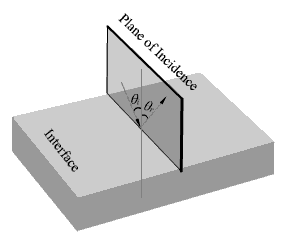SKEDSOFT
Electromagnetic waves at the interface of two dielectric mediums: When an electromagnetic wave strikes at and air dielectric interface, from air to the dielectric medium, part of it is reflected back and part of it is transmitted into the dielectric medium. The amount of light reflected and transmitted depends on the angle of incidence, refractive indices of the medium forming the interface and the angle of incidence.
Let us consider an interface formed by two dielectric medium I and II of refractive index n1 and n2 respectively as shown in fig 1.In the previous lecture we summed up the properties of electromagnetic waves and its representation. In this lecture we will be looking into the modification which an EM wave under goes when it strikes the interface of two dielectric medium.
 fig 1: The different portions of light at a material interface
fig 1: The different portions of light at a material interface
A ray of light from the medium 1 incident on the interface making an angle of incidence ![]() with normal partially gets reflected at the angle of reflection being equal to the angle of incidence and partially refracted at an angle of incidence
with normal partially gets reflected at the angle of reflection being equal to the angle of incidence and partially refracted at an angle of incidence ![]() fowling the Snell's law given by
fowling the Snell's law given by ![]() .
.
2. Reflection and the transmission coefficient as a function of angle of incidence
The amount of light reflected and refracted or transmitted depends on the optical property of the medium viz; refractive index, direction of electric field and the angle of incidence.
The direction of electric field is always perpendicular to the direction of propagation of the wave. If a wave is traveling in a certain plane the electric field vector could be in two mutually perpendicular planes which are normal to the direction of propagation. For example if the wave is propagating along z direction the electric field can be in the z-x (or z-y) plane or in x-y plane (or could be in both these planes; randomly polarized) but always perpendicular to the direction of propagation.
Similarly in the present case of interface of two dielectric media, two mutually perpendicular planes can be defined as
- The plane of the incidence containing the incidence ray, the reflected ray and the normal to the interface as shown in figure 2 and
- The plane perpendicular to the plane of incidence as shown in fig.
If the electric field is only in the plane of incidence then the wave is called as p polarized and if the electric field is perpendicular to the plane of incidence then the wave is called as s polarized.
 fig..(2)
fig..(2)